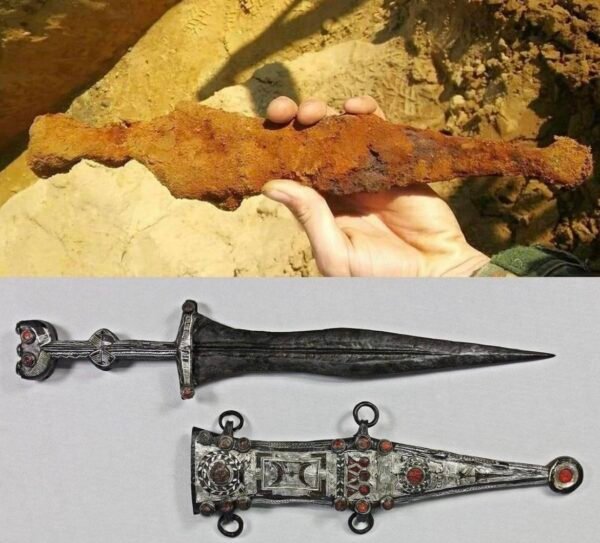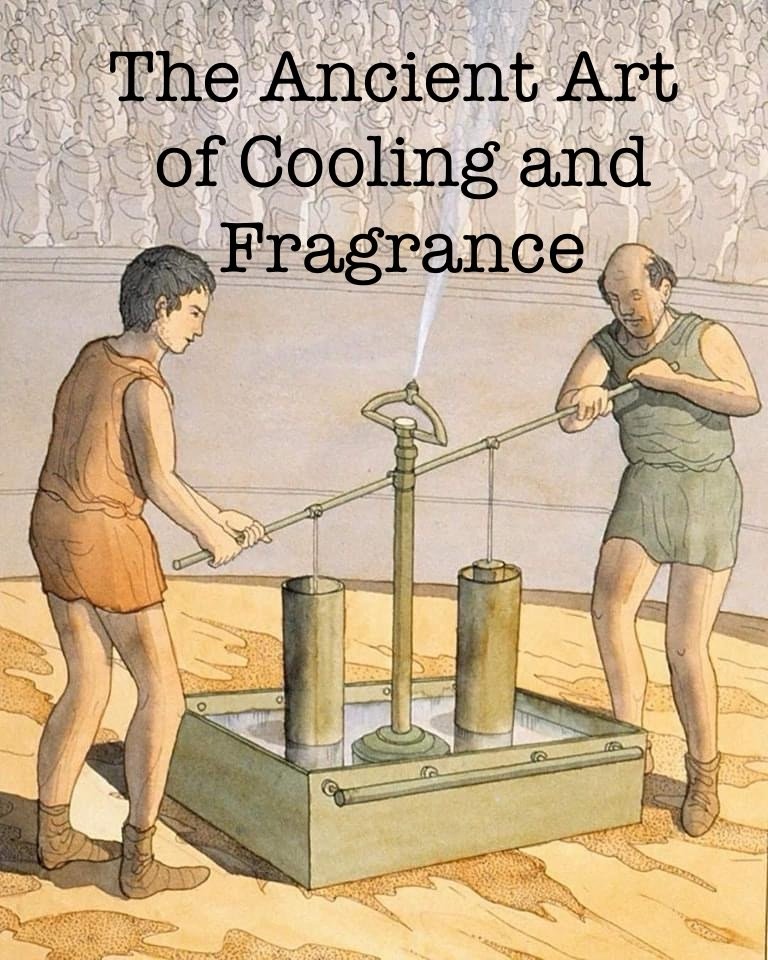In 2019, a remarkable discovery was made by an archaeology intern in Germany: a 2000-year-old Roman silver dagger. This find not only shed light on ancient Roman military history but also showcased the meticulous process of archaeological restoration.
The Discovery
The dagger was unearthed in a burial ground in Haltern am See, a town in North Rhine-Westphalia, Germany. This area was once a Roman military camp and is known for its rich archaeological significance. The intern, who was part of an excavation team, stumbled upon the artifact, which was buried alongside a Roman soldier.
The Dagger’s Significance
The silver dagger is a rare find. Roman soldiers typically carried iron daggers, known as pugiones, which were used both as tools and weapons. The discovery of a silver dagger suggests it may have belonged to a high-ranking officer. The intricate craftsmanship and design of the dagger provide insights into the artistry and metalwork skills of the Roman era.

The Restoration Process
After its discovery, the dagger underwent a meticulous nine-month restoration process. This involved carefully removing centuries of corrosion and sediment without damaging the delicate silver. The restoration team used advanced techniques to reveal the original surface of the dagger, which was adorned with intricate patterns and inscriptions.
Before and After Restoration
Before restoration, the dagger was encrusted and barely recognizable as a weapon. The restoration work, however, brought back its former glory. The silver shone once again, and the detailed engravings became visible, offering a glimpse into the past craftsmanship.
The Dagger’s Display
Post-restoration, the dagger became a centerpiece in a local museum, attracting historians, archaeologists, and enthusiasts. It serves as a tangible connection to the ancient Roman military presence in Germany and is a testament to the skill of ancient artisans.
The Impact on Archaeology and History
This discovery and subsequent restoration have significant implications for the study of Roman history and archaeology. It provides a rare look into the personal belongings of a Roman soldier and contributes to our understanding of Roman military culture and artistry.

Unveiling the Mysteries of the Ancient Roman World
The discovery of the 2000-year-old Roman silver dagger is more than just an archaeological triumph; it’s a portal into the ancient world, offering a rare glimpse into the life and times of Roman soldiers. In Roman’s times they also used to have cooling systems in place that were Roman Sparsiones. When a crowd was watching a battle, when it was very hot they could be quickly cooled down.
The Historical Context of the Dagger
The Roman Empire, known for its military prowess and expansive territory, left behind a wealth of artifacts that continue to intrigue modern historians. The dagger, found in a region that was once a Roman military camp, provides a tangible link to the Roman soldiers who lived and fought there. It’s a piece of history that tells a story of conquest, craftsmanship, and daily life in the Roman army.
The Artistry and Symbolism
The restored dagger reveals the high level of artistry achieved by Roman craftsmen. The intricate engravings and use of precious silver indicate that this was not a standard issue weapon but rather a symbol of status and prestige. It may have been used in ceremonies or as a personal defense weapon, reflecting the social hierarchy within the Roman military.
Insights into Roman Military Life
The location of the dagger’s discovery, in a burial ground alongside a soldier, provides insights into Roman burial practices and beliefs about the afterlife. The inclusion of a weapon in a grave suggests that Romans believed the deceased might need to defend themselves or maintain their status in the afterlife.

The Role of Archaeology
This discovery underscores the importance of archaeology in uncovering hidden aspects of ancient civilizations. Each artifact, like this dagger, adds a piece to the puzzle of our understanding of history. The work of archaeologists and restorers allows us to connect with our past in a tangible and meaningful way.
Educational and Cultural Significance
The dagger, now displayed in a museum, serves an educational purpose, offering the public a chance to engage with history directly. It’s not just an object behind glass; it’s a story and a piece of art that continues to educate and inspire.
Future Implications
The discovery of the Roman silver dagger opens the door for further archaeological exploration in the area. It raises questions about what other artifacts might lie buried, waiting to be discovered and restored. Each new find has the potential to alter our understanding of history, shedding light on the complexities of ancient civilizations.
Questions and Answers About the 2000-Year-Old Roman Silver Dagger
What does the discovery of the silver dagger tell us about Roman military ranks? The discovery suggests a distinction in ranks within the Roman military. The use of silver, a precious metal, indicates that the dagger likely belonged to a higher-ranking officer. This aligns with historical knowledge that Roman military hierarchy was complex and rank often influenced the type of equipment a soldier possessed.
How rare is it to find silver weapons from the Roman era? Finding silver weapons from the Roman era is quite rare. Most Roman military artifacts, especially weapons, were made of iron. Silver weapons were not common and are often considered to be ceremonial or indicative of high status.
What kind of engravings were found on the dagger? The exact details of the engravings on this particular dagger aren’t specified, but typically, Roman engravings included intricate patterns, symbols of military legions, or images of gods and goddesses. These engravings were not only decorative but also held symbolic significance.
How were artifacts like this dagger preserved for 2000 years? Artifacts like this dagger are preserved due to a combination of factors, including the materials they are made from, the conditions of their burial, and sometimes just sheer luck. Over time, they can become covered in corrosion and sediment, which actually protects the underlying material. Controlled excavation and restoration are crucial in uncovering and preserving these artifacts.
What challenges do restorers face when working on ancient artifacts like this dagger? Restorers face several challenges, including handling fragile materials, removing centuries of corrosion without damaging the artifact, and preserving any remaining original surfaces. They must balance the need to clean and stabilize the artifact with the goal of preserving its historical integrity.
Can the public view this dagger? Where is it displayed? Yes, the public can view the dagger. After its restoration, it was displayed in a local museum. Museums often host such artifacts to allow the public to connect with historical discoveries. The exact location can typically be found through a museum’s website or press releases.
What impact does such a discovery have on our understanding of Roman history? Discoveries like this dagger provide tangible evidence of Roman military practices and social structures. They offer insights into the craftsmanship, artistry, and daily life of the time, helping historians and archaeologists piece together a more detailed picture of the Roman world.
The discovery and restoration of the Roman silver dagger not only represent a significant archaeological achievement but also a fascinating window into the past, offering a glimpse into the lives and practices of those who lived two millennia ago.
Other cool content we have…
The discovery of the 2000-year-old Roman silver dagger is a fascinating glimpse into the past, much like the intriguing stories and historical insights available at History Time Machine. Here are some articles from our website that delve into various aspects of history, offering a deeper understanding and appreciation of different eras:
A Day in the Life of a 1950s Milkman
In “A Day in the Life of a 1950s Milkman”, we explore the role of the milkman in 1950s America. This piece offers a nostalgic look at a profession that was once a staple in neighborhoods across the country, highlighting the cultural and social dynamics of the era.
Robin Williams: His Early Life
The article “Robin Williams: A Glimpse into His Early Life with His Mother” provides an intimate look at the early years of the beloved comedian and actor. It sheds light on how his upbringing and relationship with his mother shaped his extraordinary journey in life and entertainment.
1939 Durham: A Cultural Snapshot
In “1939 Durham: Walcott’s Lunch Stand & Tobacco Photo”, we take a step back in time to Durham, North Carolina, in 1939. This article offers a snapshot of the era, capturing the essence of the region’s cultural fabric through a single photograph.
At History Time Machine, we strive to bring history to life through engaging stories and insightful articles. Whether it’s exploring the daily life of a 1950s milkman, understanding the early influences of a famous comedian, or taking a photographic journey to the past, our articles provide a window into the diverse and rich tapestry of human history. Visit History Time Machine to explore more articles and embark on your own journey through time.
As an Amazon Associate we earn from qualifying purchases through some links in our articles.




